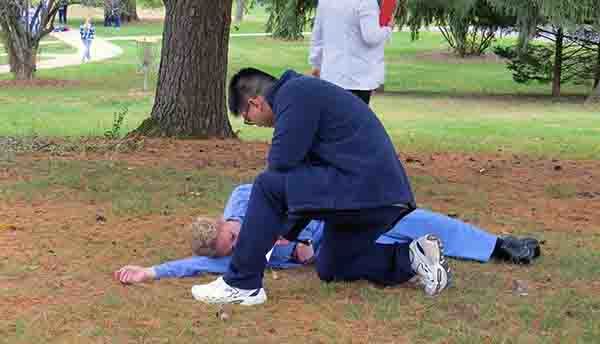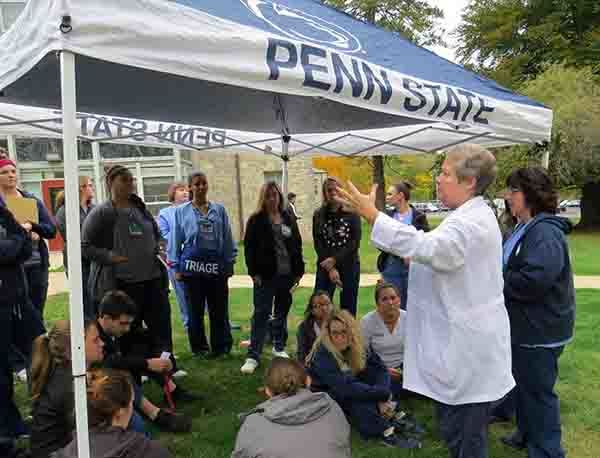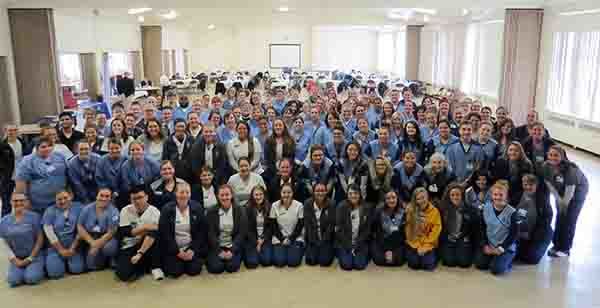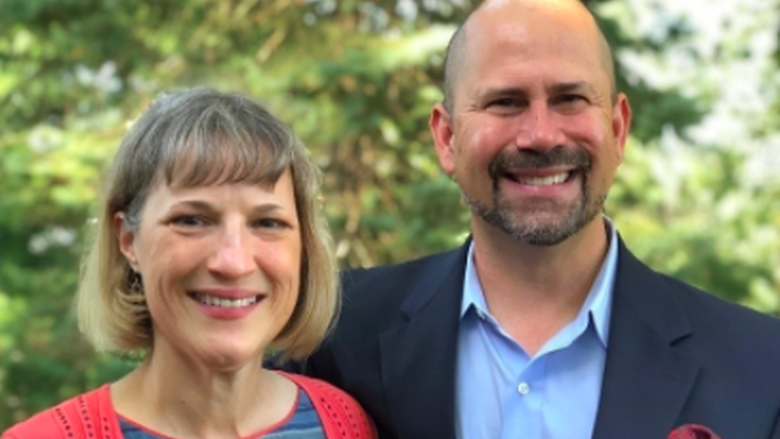
Penn Sate Mont Alto nursing student Ben Cai checks on a "casualty" during a training exercise on Oct. 26 on the campus of Wilson College.
MONT ALTO, Pa. — More than 100 nursing students from four different area schools converged on the campus of Wilson College on Saturday, Oct. 26, for “Community Simulation Day” — a mass-casualty scenario where, with help from local community emergency response crews, students practiced assessing and treating “victims” of a mock shooting.
The day began with speakers in the morning, followed by the simulation in the afternoon. Nursing students from the Wilson, Penn State Mont Alto and HACC-Gettysburg nursing programs and the Franklin County Career and Technology Center’s (FCCTC) Practical Nursing Program formed four groups with assigned roles. Some of the students in each group were assigned specific injuries — including gunshot wounds of different severities, chest pain, dislocated shoulder and lacerations — and the rest acted as healthcare professionals treating the victims.
Local police and emergency medical technicians (EMTs) were on hand to help give students the simulated feel of a real-life, mass-casualty event.
After the simulation, students evaluated their responses and discussed what they learned from the exercise. Their objectives included: learning to evaluate injuries, prioritize care and triage the patients while maintaining a safe environment and ensuring clear, effective communication.
Amanda Seese, a HACC nursing student who was one of the group leaders, said the exercise was valuable in giving students hands-on training for a real disaster. “I do think this was a great clinical day,” Seese said. “And it was nice to work with other colleges and people we’re not used to working with.”
Miranda Rhodes, a Penn State Mont Alto nursing student, found the opportunity to work with students at other schools especially helpful.
“As much as the topic of the simulation is really important, because active shootings are something we have to deal with now, I think the fact that we got to do this with other schools is equally important,” said Rhodes, who was a group leader. “If you’re in a mass-casualty situation, you’re not going to know everybody that you’re working with.”
Kelli Ellerman, an FCCTC LPN student and another group leader, said the simulation was worthwhile because it forced those participating to use critical thinking and judgement skills. “I thought it was a good learning experience,” she said. “You have to think on your feet when you go out there. There’s no one holding your hand.”
Wilson Chief Nursing Officer Julie Beck came up with the idea for the simulation, which has been planned for more than a year.
“This is an exciting day because this has never been done before,” Beck said. “For the first time we are having a collaborative simulation being performed at Wilson College using the varied educational backgrounds of all nursing students in the area coming together.”
The nursing programs that participated in the simulation provide different levels of education. Wilson and Penn State Mont Alto offer bachelor’s degrees in nursing, HACC has an associate degree program, and FCCTC trains licensed practical nurses (LPNs). Because graduates of the programs will function at different levels in the real world, Beck believes it’s important to bring them together for an exercise like the simulation.
“Many times there is this idea of almost like a caste system in nursing,” she said. “I feel strongly that if these students are going to be graduating from our local programs, it’s really important for them to get to know each other before they’re actually at the bedside. Everyone should learn what we do in a situation like this, no matter what their program.”
Students said they appreciated the chance to work with counterparts at other schools. “I think it made it more realistic,” said Sarah Gipe, a senior in Wilson’s nursing program and one of the group leaders.
“We all will work together at some point,” said Tara Harmon, another Wilson nursing student and team leader. “We got to work with LPN students and see what they do, and they got to see what we do. We all bring something to the table.”
The day began in the morning with breakfast and registration in Wilson’s Laird Hall, followed by educational sessions and speakers. Topics included the nation’s opioid crisis, how to manage an active shooter situation, and an overview of a national program called “Stop the Bleed.” Students also were introduced to a method of triaging patients called SALT, which they later used during the simulation. SALT stands for sort, assess, lifesaving interventions, and treatment/transport.
The simulation was purposely low-key because it was the first time a mock disaster collaboration had been tried. Nursing officials plan to hold future simulations at the participating schools on a rotating basis.







